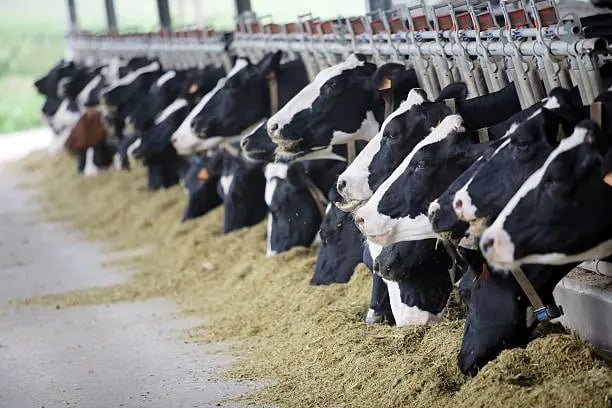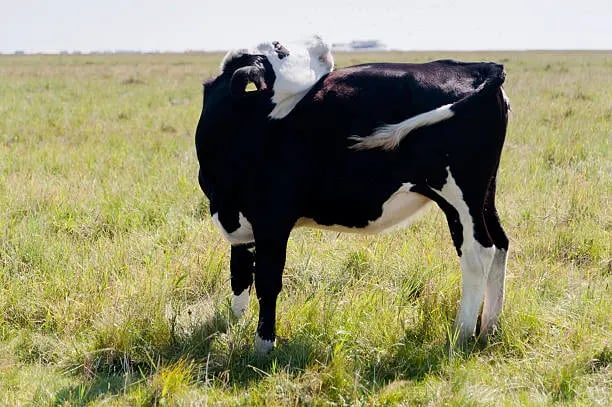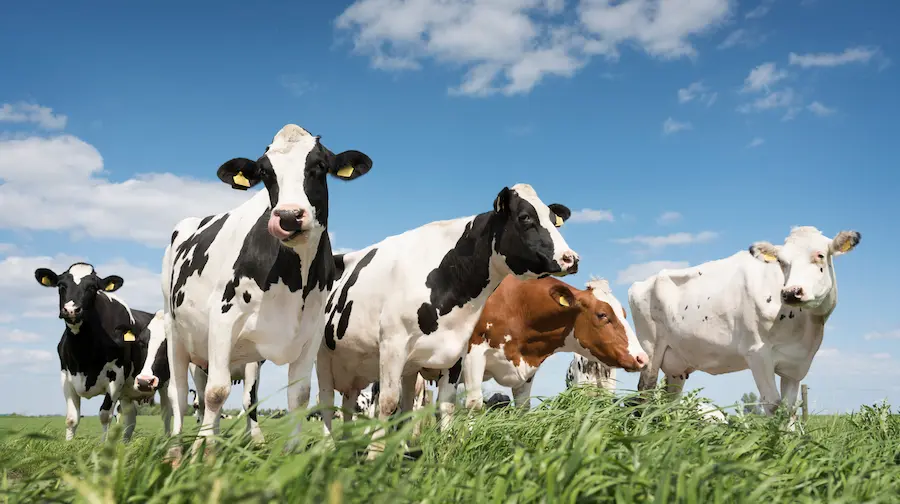Feeding dairy cows continues to be challenging. Matchmaking nutritional requirements, productivity, health, welfare, minimize emissions and promote eco-system services while providing nutritional food for Humans is a very complex exercise. GHG mitigation strategies set the path for current and future trends, specially went the go side by side with improved efficiency and productivity goals.
Prefer to listen to this article? Click the play button below and enjoy our podcast!
Opportunities exist and are being developed to decrease GHG emissions in cattle. Some of these options require novel technological interventions, others are “simple” principles that can be applied already in most production systems. Farmers and nutritionists should work together providing tailored made solutions for each farm, and ideally, each animal.
Feeding the rumen and feeding behavior
Feeding the cow is feeding the rumen. Ensuring a healthy and stable rumen is more than halfway to have a productive, efficient, and healthy cow. An unhealthy rumen will lead to inconsistent feed intake, microbial changes, poorer efficiency, ... It is all about keeping the balance in fermentation. Another aspect one should always keep in mind is feeding behavior, since it has an important effect on rumen function.
Feeding behavior is highly linked with dry matter intake (DMI). Parameters like meal size, time of meals, time ruminating etc. are important to track and observe to improve welfare conditions of cows and thus productivity. Greater DMI is associated with more time eating per day and having more frequent meals per day, these feeding behavior patterns lead to a more stable and consistent rumen environment.

Improving feed quality and digestibility
Low-quality and low-digestibility feeds result in relatively high enteric emissions per unit of milk, particularly in systems with low productivity. Improving feed digestibility and energy content, and better matching protein supply to animal requirements can be achieved through better grassland management, improved pasture species, changing forage mix and greater use of feed supplements to achieve a balanced diet, including cropping by-products and processing of crop residues. Changes in feed production with the use of legumes (forage legumes in grassland, grain legumes) which reduce the use of nitrogen fertilizers and improve feed quality may reduce both N2O and CH4 emission to some extent.
Feed additives
Unsaturated fatty acids (oil seeds), molecules, such as nitro-oxy derivatives (3NOP and methyl 3NOP) can reduce enteric CH4 emissions up to 30% without negative effects on performance over several lactations. However, the presence of residues in milk or meat remains an unresolved issue apart linseed product that increase omega-3 contents in animal product and can thus be considered as a win-win strategy. Plant secondary compounds are the subject of numerous studies but with results that are not always convincing. Algae seem to provide interesting results. Studies with red algae Asparagopsis show amazing results in decreasing methane production in the rumen. However, issues regarding residues of bromoform compost in meat or milk are still under further analysis. Other macroalgae (Ulva) are also under study, but with lower reductions in vivo. Micro algae provide good results in vitro, but in vivo studies are being conducted.
Circularity approach in feed: promote the use of co-products in feeding
Circularity in feed production is a concept that is still in the process of being defined. Co-products used in feed, are in general considered human inedible feed, due to the high amount of fiber, anti-nutrients or other characteristics that make the feed of “non-food” grade quality. This means these feed resources are not in direct competition with food consumption, while at the same time making a significant contribution to food security. FAO has estimated that at global level 86% of livestock feed is not suitable for human consumption. Co-products from agro-food industries or green chemistry, former foodstuffs and alternative protein sources (incl. insects, other invertebrates, yeast, bacteria/single cell proteins…) must be mobilized as feed.
Product Environmental Footprint (PEF) in feed formulation
Identifying GHG emissions related to feed materials production is starting to be a “must have” information in feed. Currently tools to formulate with this parameter in the formulation matrix are available. Together with global feed industry partners, FEFAC invested in the development of the GFLI Database, containing the most comprehensive information source for datasets on the environmental impacts of the feed materials sourced by compound feed manufacturers.

Precision feeding
Precision feeding is about getting the right nutrient to the right animal at the right time. The animal’s requirements change during their lifetime and cycles of reproduction. Understanding an animal’s need on a daily basis can result in major efficiency gains. Precision feeding will increase feed efficiency and productivity and consequently can improve farm profitability. Customised balanced feeding programmes in grazing dairy cattle systems have shown to increase productivity and reduce enteric methane emissions intensity (15-20%) and also N excretion (20-30%), which results in reduced emissions from manure.
Implementation barriers
Precision feeding requires investment in new technologies, capital, knowledge and different management practices. Access to information and up-skilling of farm managers may be limited and rely on knowledge transfer and training programs; successful implementation can also depend on adequate supply chains and infrastructure. Costs of feed substitutes and supplements, and technologies to support precision feeding, may counteract economic bene- fits from increased productivity.
Take home messages
Future paths in dairy feeding will surely continue to pass through GHG mitigation feeding strategies, even more since several possible solutions are still being studied.
References
Global Research Alliance on Agricultural GHG Emissions. Reducing greenhouse gas emissions from livestock: Best practice and emerging options. PDF: ISBN 978-0-473-30433-1. www.globalresearchalliance.org
Martins, L.F., Wasson, D.E. & Hristov, A.N., 2022. Feeding dairy cows for improved metabolism and health. Animal Frontiers 12(5): 29–36.
https://www.ncbi.nlm.nih.gov/pmc/articles/PMC9564990/
Mahfuzul Islam & Sang-Suk Lee, 2019. Advanced estimation and mitigation strategies: a cumulative approach to enteric methane abatement from ruminants. J Anim Sci Technol 2019;61(3):122-137 https://www.doi.org/10.5187/jast.2019.61.3.122
FEFAC, 2022. Circular feed: optimised nutrient recovery through animal nutrition. https://fefac.eu/wp-content/uploads/2022/07/FEFAC-Circular-Feed-Publication-13-June-2022.pdf
FEFAC, 2023. Advanced feeding strategies for enhanced and circular sustainable livestock and aquaculture production how do they work? https://fefac.eu/wp-content/uploads/2023/06/Final_Advanced-Feeding-Strategies_Brochure_Print_WEB.pdf
About the author
Ana Sofia Santos (Head of Research and Innovation at FeedInov CoLAB)
Ana Sofia Santos holds a MSc in Animal Production and a PhD in Animal Science, both on the Nutrition area. She is currently Head of research and Innovation at FeedInov CoLAB, an interface structure between the academia and the animal feed industry, promoting innovative approaches to animal feeding. Her current area of research interest resides on animal production systems and the integration of livestock and plant production systems within a holistic vision of circularity in food production.
Explore author’s articles



Leave your comments here